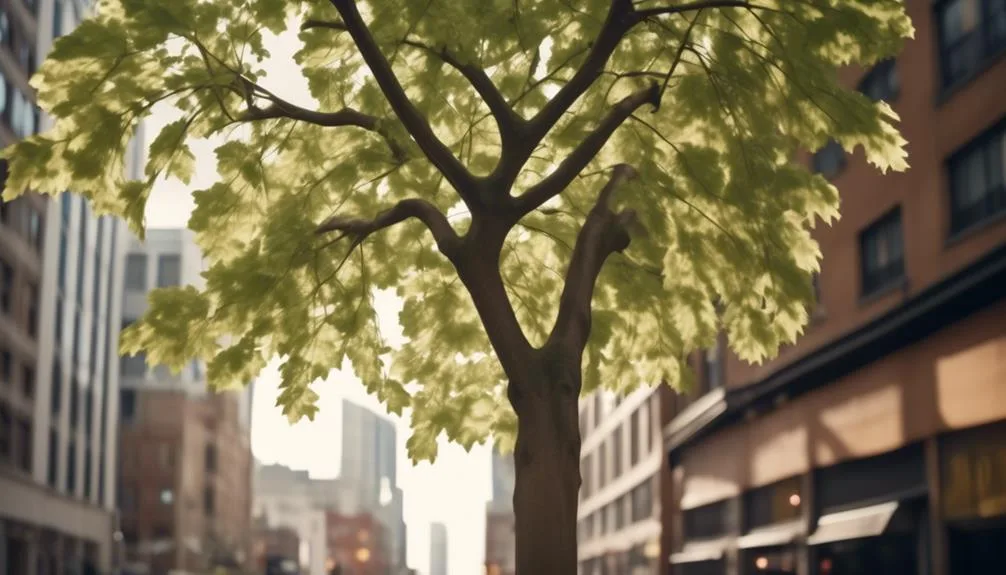Sycamore trees can absorb 48 pounds of carbon dioxide per year.
But can these trees thrive in urban areas? This question has caught the attention of urban planners and environmental enthusiasts as cities grow.
The importance of green spaces in cities is clear.
The answer to this question may surprise you, and its implications are significant.
Suitable Urban Environments for Sycamore Trees
Sycamore trees thrive in diverse urban environments, from bustling city centers to quiet residential neighborhoods, adding beauty and vitality to their surroundings. Their broad tree canopy provides shade, which helps combat urban heat, making them ideal for urban areas.
However, urban settings often come with challenges such as soil compaction, which can impede the growth of tree roots. It's important to address this issue by using techniques like aeration and mulching to loosen the soil and provide a healthier environment for sycamore tree roots to spread.
Despite these challenges, sycamore trees can adapt well to urban environments with the right care, enhancing the urban landscape with their striking appearance and providing essential environmental benefits.
Growth Characteristics of Sycamore Trees in Urban Areas
Thriving in diverse urban environments, sycamore trees' growth characteristics adapt to the challenges of urban settings, contributing to the vitality and beauty of their surroundings.
Sycamore trees possess extensive root systems that can grow deep into the ground, making them adaptable to urban areas with limited space by spreading horizontally rather than requiring deep soil. They're also known for their tolerance to various soil qualities, including compacted and urban soils.
Sycamores have a moderate to high water requirement, making them suitable for urban areas where water availability may fluctuate. Additionally, these trees have a remarkable ability to withstand pollution, making them resilient in urban settings where air quality may be a concern.
Potential Challenges for Sycamore Trees in Urban Settings
Sycamore trees encounter several hurdles in urban environments, but they possess remarkable resilience and adaptability. Here are some potential challenges and adaptation strategies:
- Root space: Urban settings often limit the availability of adequate root space for sycamore trees to spread and establish a strong foundation.
- Pollution tolerance: Sycamore trees must cope with higher pollution levels in urban areas, which can impact their overall health and growth.
- Competition for resources: In urban settings, sycamore trees compete with other vegetation, buildings, and infrastructure for sunlight, water, and nutrients.
- Stress from urban activities: Urban settings expose sycamore trees to disturbances from construction, vehicular traffic, and human activities, leading to increased stress and potential damage.
Despite these challenges, sycamore trees have demonstrated a remarkable ability to adapt and thrive in urban environments.
Benefits of Planting Sycamore Trees in Urban Environments
Planting sycamore trees in urban environments offers numerous benefits, contributing to the overall well-being and sustainability of the community.
The environmental impact of sycamore trees is significant, as they act as natural air purifiers, filtering out pollutants and releasing clean oxygen into the atmosphere.
Their large canopies provide shade, reducing the urban heat island effect and lowering energy costs.
Sycamore trees also aid in stormwater management by absorbing excess water and reducing the risk of flooding.
Additionally, their presence enhances community engagement, providing a natural gathering space for residents to connect with nature and each other.
Best Practices for Cultivating Sycamore Trees in Urban Settings
To ensure the successful cultivation of sycamore trees in urban settings, it's essential to carefully consider the local environmental conditions and the specific needs of these majestic trees. When cultivating sycamore trees in urban settings, consider the following best practices:
- Soil Composition: Ensure the soil is well-draining and rich in nutrients to support healthy sycamore growth.
- Pruning Techniques: Regularly prune to remove dead or diseased branches and encourage proper growth and structure.
- Watering Frequency: Provide consistent watering, especially during dry periods, to keep the soil moist but not waterlogged.
- Root System: Be mindful of the expansive root system and avoid planting sycamore trees too close to buildings or underground utilities.
Conclusion
In urban settings, sycamore trees thrive with proper care, offering shade, beauty, and environmental benefits.
Overcoming challenges to plant and nurture these majestic trees contributes to a greener urban landscape.
Consider the rewards of planting a sycamore tree in your city – it's a worthwhile endeavor that enhances the urban environment for all.
Mark Hoffman is a dedicated arborist and tree care specialist with over a decade of experience. His love for trees began when he visited Yosemite National Park as a teenager and was awestruck by the giant sequoias. Mark pursued his passion by studying forestry at Michigan Technological University, where he earned a Bachelor of Science degree.
Since then, he has worked tirelessly in the field of arboriculture, helping to preserve and protect trees in his community. His expertise and dedication have made him a respected leader in the industry and a valuable resource for anyone seeking advice on tree care.
